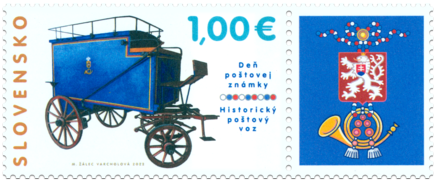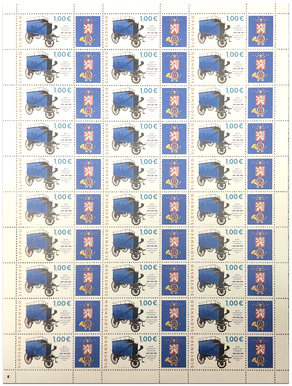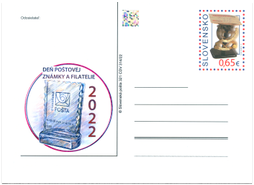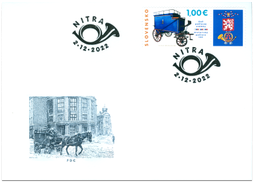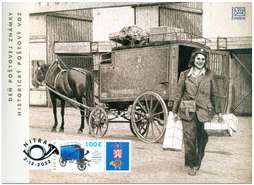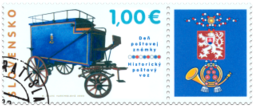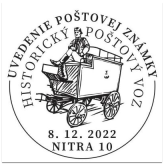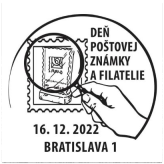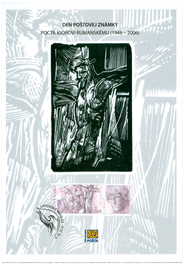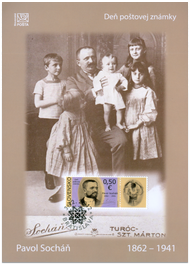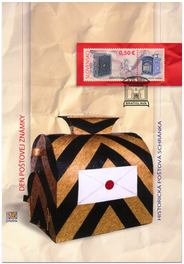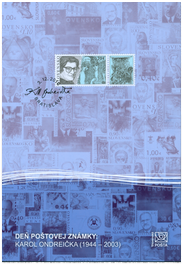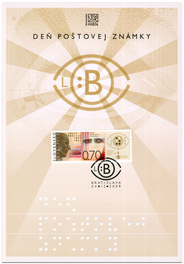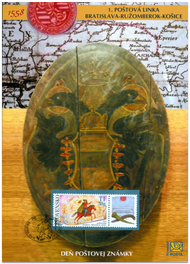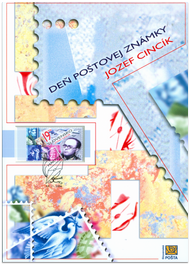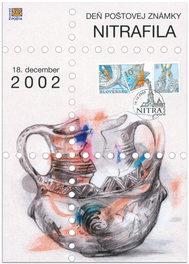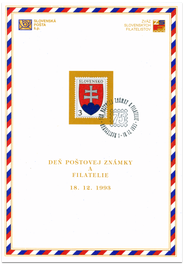783 Date of issue
02.12.2022 Face value
1.00 € Sell price
1.00 €
As early as the ancient Roman Empire the state-run postal service (cursus publicus), established by the emperor Augustus (27 BC – 14 AD), used various types of vehicles to transport not only people but also the post. Although letters were usually delivered by riders on horseback, the transport of larger consignments, goods or people required the use of light weight two-wheeled (carrus) or four-wheeled vehicles (raeda).
The vehicular transport of mail did not develop in the early Middle Ages, messengers mainly went on foot or on horseback. In the late 15th century a new type of vehicle emerged: a coach that was remarkable for its light weight and speed, thus it began to be used to transport the royal mail and by couriers. In the 1740s, during the period of reform of Maria Theresa, the transportation of mail was further developed and stabilised. Therefore, the Habsburg monarchy started to consider the use of special vehicles, the diligencia (a stagecoach), for the transport of mail, following the examples of England and France. The diligencia successfully passed its road tests and the operation of the diligencias was taken over by the state as early as 1750. At the beginning of the 19th century, there was a need to improve the quality and particularly the speed of postal deliveries. In 1823, Maximilian Otto von Ottenfeld, the new director of the administration of mail coaches, initiated reforms of the transport of people and the mail. He established regular lines using comfortable and well sprung coaches (Eilpostwagen) that even travelled the postal routes at night.
The introduction of the railways provided a new means for the transport of people and the post. As early as 1838 the first post train was established in England, whose employees sorted letters and parcels while the train was in motion. The sorted mail was then unloaded at railway stations along the way and parcel delivery coaches transported it to the individual post offices. The transport of mail from post offices was solved in the same way. The cargo area of this parcel coach was usually consisted of wooden sheet-metal cabinet drawn by one or more horses. This type of vehicle was still in use until 1960, when were fully replaced by motor vehicles.
The postage stamp and FDC surcharge depicts an example of such a parcel delivery coach. It was used by the Czechoslovak postal operator in the inter-war period. The blank field was inspired by the emblem used by the Czechoslovak State Post on its coaches.
Leo Lichvár
Show lessSimilar products
103 NL 554/13 Date of issue
06.12.2013
97 NL 530/12 Date of issue
03.12.2012
092 NL 508/11 Date of issue
02.12.2011
088 NL 488/10 Date of issue
03.12.2010
084 NL 466/09 Date of issue
04.12.2009
081 NL 436/08 Date of issue
27.11.2008
074 NL 412/07 Date of issue
28.11.2007
068 NL 388/06 Date of issue
24.11.2006
065 NL 367/05 Date of issue
25.11.2005
055 NL 283/02 Date of issue
18.12.2002
001 NL 001/93 Date of issue
18.12.1993
003 NL 002/93 Date of issue
18.12.1993
© 2024 POFIS - Postal philatelic service. All rights reserved

